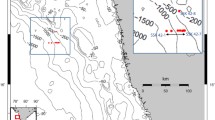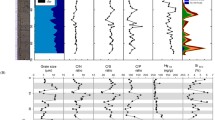Abstract
It is hypothesized that in the deep-sea, under psychrophilic, barophilic and oligotrophic conditions, microbial community of Central Indian Basin (CIB) sediments could be chemosynthetic. In the dark, at near ambient temperature, 4 ± 2°C, 500 atm pressure, pelagic red clay could fix carbon at rates ranging from 100 to 500 nmol C g−1 dry wt day−1. These clays accumulate in the deepest and the most remote areas of the ocean and contain <30% biogenic material. These clays with volcanic signatures fixed 230–9,401 nmol C g−1 dry wt day−1 while siliceous radiolarian oozes of the basin fixed only 5–45 nmol C g−1 dry wt day−1. These rates are comparable to those of white smoker waters and are 1–4 orders of magnitude less than those of bacterial mats and active vents recorded at other localities worldwide. The experimental ratios of carbon fixation to metal oxidation in the sediments were 0–1 order of magnitude higher than the corresponding average theoretical ratio of 0.0215 (0.0218, 0.0222, 0.0207 and 0.0211 for Fe, Mn, Co and Ni, respectively) in the siliceous ooze. In case of pelagic red clay it was 0–2 orders higher than theoretical ratio. Thus, chemosynthetic activity could be more widespread, albeit at low rates, than previously considered for abyssal basins. These environments may be dependent partially or even wholly on in situ microbial primary production for their carbon requirements rather than on photosynthetically derived detritus from surface waters.







Similar content being viewed by others
References
Aldrich AP, van der Berg CMG (1998) Determination of Fe and its redox speciation in seawater using catalytic cathodic stripping voltametry. Electroanal 10(6):369–373
Antony R, Sujith PP, Fernandes SO, Verma P, Khedekar VD, LokaBharathi PA (2010) Cobalt immobilization by manganese oxidizing bacteria from the Indian Ridge System. Curr Microbiol. doi:10.1007/s00284-010-9784-1
Bach W, Edwards K (2003) Iron and sulphide oxidation within the basaltic ocean crust: implications for chemolithoautotrophic microbial biomass production. Geochim Cosmochim Acta 67(20):3871–3887
Bligh EG, Dyer WJ (1959) A rapid method of total lipid extraction and purification. Can J Biochem Physiol 37:911–917
Casamayor EO, Garcia-Cantizano J, Mas J, Pedros-Alio C (2001) Microbial primary production in marine oxic–anoxic interfaces: main role of dark fixation in the Ebro River salt wedge estuary. Mar Ecol Prog Ser 215:49–56
Casamayor EO, Garcia-Cantizano J, Pedros Alio C (2008) Carbon dioxide fixation in the dark by photosynthetic bacteria in sulphide rich stratified lakes with oxic–anoxic interfaces. Limnol Oceanogr 53(4):1193–1203
Chase RL, Delaney JR, Karsten JL, Johnson HP, Juniper SK, Lupton JE, Scott SD, Tunnicliffe V, Hammond SR, McDuff RE (1985) Hydrothermal vents on an axis seamount of the Jaun de Fuca ridge. Nature 313:212–214
Chester R, Hughes MJ (1968) Scheme for the spectrophotometric determination of Cu, Pb, Ni, V and Co in marine sediments: applied earth science. Trans Inst Miner Metall 77:37–41
Chevaldonne P, Desbruyeres D, Le Haitre M (1991) Time-series of temperature from three deep-sea hydrothermal vent sites. Deep Sea Res A 38:1417–1430
Childress JJ, Fisher CR, Favuzzi JA, Kochevar RE, Sanders NK, Alayse AM (1991) Sulphide-driven autotrophic balance in the bacterial symbiont-containing hydrothermal vent tubeworm Riftia pachyptila. Biol Bull 180:135–153
Chin CS, Johnson KS, Coale KH (1992) Spectrophotometric determination of dissolved manganese in natural waters with 1-(2-pyridylazo)-2-naphthol: application to analysis in situ in hydrothermal plumes. Mar Chem 37:65–82
Culver DA, Brunskill GJ (1969) Fayetteville Green Lake, New York. V. Studies of primary production and zooplankton in a meromictic marl lake. Limnol Oceanogr 14:862–873
Danovaro R, Fabiano M, Della Croce N (1993) Labile organic matter and microbial biomass in deep sea sediments (Eastern Mediterranean sea). Deep-sea Res 40:953–965
Das A, Fernandes CEG, Naik SS, Nagender Nath B, Suresh I, Mascarenhas-Pereira MBL, Gupta SM, Khadge NH, Prakash Babu C, Borole DV, Sujith PP, Valsangkar AB, Mourya BS, Biche SU, Sharma R, LokaBharathi PA (2010) Bacterial response to contrasting sediment geochemistry in Central Indian Basin. Sedimentology. doi:10.1111/j.1365-3091.2010.01183.x
Dattagupta S, Miles LL, Barnabei MS, Fisher CR (2006) The hydrocarbon seep tubeworm Lamellibrachia luymesi primarily eliminates sulfate and hydrogen ions across its roots to conserve energy and ensure sulfide supply. J Exp Biol 209:3795–3805
Dattagupta S, Telesnicki G, Luley K, Predmore B, McGinley M, Fisher CR (2007) Submersible operated peepers for collecting porewater from deep-sea sediments. Limnol Oceanogr: Methods 5:263–268
Edwards KJ, Bach W, McCollom TM (2004) Neutrophilic iron-oxidizing bacteria in the Ocean: their habitats, diversity, and roles in mineral deposition, rock alteration, and biomass production in the deep-sea. Geomicrobiol J 21:393–404
Ehrlich HL (1998) Geomicrobiology: its significance for geology. Earth-Sci Rev 45:45–60
Flemming BW, Delafontaine MT (2000) Mass physical properties of muddy intertidal sediments: some applications misapplications and non-applications. Cont Shelf Res 20:1179–1197
García-Cantizano J, Casamayor EO, Gasol JM, Guerrero R, Pedros-Alio C (2005) Partitioning of CO2 incorporation among guilds of microorganisms in lakes with oxic-anoxic interfaces and estimation of in situ specific growth rates. Microb Ecol 50:230–241
Gupta SM, Jauhari P (1994) Radiolarian abundance and geochemistry of the surface sediments from the central Indian Basin. Curr Sci 66(9):659–663
Hatzikioseyian A, Tsezos M (2006) Modelling of microbial metabolism stoichiometry: application in bioleaching processes. Hydrometallurgy 83:29–34
Hobbie JE, Daley RJ, Jasper S (1977) Use of nucleopore filters for counting bacteria by fluorescent microscopy. Appl Environ Microbiol 3:1225–1228
Jannasch HW (1989) Chemosynthetically sustained ecosystems in the deep sea. In: Schlegel HG, Bowien B (eds) Autotrophic bacteria. Springer, Berlin, Heidelberg, New York, pp 147–166
Jørgensen BB, Kuenen JG, Cohen Y (1979) Microbial transformation of sulfur compounds in a stratified lake (Solar Lake, Sinai). Limnol Oceanogr 24:799–822
Jørgensen BB, Fossing H, Wirsen CO, Jannasch HW (1991) Sulfide oxidation in the anoxic Black Sea chemocline. Deep-sea Res 38(suppl.2):1083–1103
Juniper SK, Brinkhurst RO (1986) Water-column dark CO2 fixation and bacterial-mat growth in intermittently anoxic Saanich Inlet, British Columbia. Mar Ecol Prog Ser 33:41–50
Kamesh Raju KA, Ramprasad T (1989) Magnetic lineations in the Central Indian Basin for the period A24–A21: a study in relation to the Indian Ocean Triple Junction trace. Earth Planet Sci Lett 95(3/4):395–402
Karl DM (1995) Ecology of free-living, hydrothermal vent microbial communities. In: Karl DM (ed) The microbiology of deep-sea hydrothermal vents. CRC Press, Boca Raton, FL, pp 35–124
Kato C, Sato T, Horikoshi K (1995) Isolation and properties of barophilic and barotolerant bacteria from deep-sea mud samples. Biodivers Conserv 4:1–9
Kochert G (1978) Carbohydrate determined by the phenol-sulfuric acid method. In: Hellebust JA, Craigie JJ (eds) Handbook of physiological methods: physiological and biochemical methods. Cambridge University Press, Cambridge, pp 95–97
Levin LA, Michener RH (2002) Isotopic evidence for chemosynthesis-based nutrition of macrobenthos: The lightness of being at Pacific methane seeps. Limnol Oceanogr 47(5):1336–1345
LokaBharathi PA (1989) The occurrence of denitrifying colourless sulphur-oxidizing bacteria in marine waters and sediments as shown by the agar shake technique. FEMS Microbiol Ecol 62:335–342
LokaBharathi PA, Ortiz-conde BA, Nair S, Chandramohan D, Colwell RR (1994) FiveS rRNA sequences and fatty acid profiles of colourless sulfur-oxidising bacteria Ocean technology: perspectives. In: Sushilkumar, Agadi VV, Das VK, Desai BN (eds) Symposium on ocean technology. National Institute of Oceanography, Goa, India, 27–29 August 1992. Publ and Inf Dir, New Delhi, India
Lowry OH, Rosebrough NJ, Farr AL, Randall RJ (1951) Protein measurement with the Folin-Phenol reagents. J Biol Chem 193:265–275
Mandernack KW, Tebo BM (1999) In situ sulfide removal and CO2 fixation rates at deep-sea hydrothermal vents and the oxic–anoxic interface in Framvaren Fjord, Norway. Mar Chem 66:201–213
Mascarenhas-Pereira MBL, Nath BN, Borole DV, Gupta SM (2006) Nature, source and composition of volcanic ash in sediments from a fracture zone trace of Rodriguez Triple Junction in the Central Indian Basin. Mar Geol 229(1):79–90
McCarty PL (1965) Thermodynamics of biological synthesis and growth. In: Baers J (ed) Advances in water pollution research. Proceedings of 2nd international conference on water pollution research. Pergamon Press, Oxford, pp 169–199
McCarty PL (1975) Stoichiometry of biological reactions. Prog Water Technol 7:157–172
Mukhopadhyay R, Iyer SD, Ghosh AK (2002) The Indian Ocean Nodule Field: petrotectonic evolution and ferromanganese nodules. Earth Sci Rev 60:67–130
Nath BN, Mudholkar AV (1989) Early diagenetic processes affecting nutrients in the pore waters of Central Indian Ocean cores. Mar Geol 86:57–66
Nath BN, Borole DV, Aldahan A, Patil SK, Mascarenhas-Pereira MBL, Possnert G, Ericsson T, Ramaswamy V, Gupta SM (2008) 210Pb, 230Th, and 10Be in Central Indian Basin seamount sediments: signatures of degassing and hydrothermal alteration of recent origin. Geophys Res Lett 35:L09603. doi:10.1029/2008GL033849
Nelson DC, Wirsen CO, Jannasch HW (1989) Characterisation of large, autotrophic Beggiatoa species abundant at the hydrothermal vents of the Guaymus Basin. Appl Environ Microbiol 55:2909–2917
Pai SC, Gong GC, Liu KK (1993) Determination of dissolved oxygen in seawater by direct spectrophotometry of total iodine. Mar Chem 41:343–351
Paropkari AL, Prakash Babu C, Mascarenhas A (1992) A critical game of depositional parameters controlling the variability of organic carbon in Arabian Sea sediments. Mar Geol 107:213–226
Patience RL, Clayton CJ, Kearsley AT, Rowland SJ, Bishop AN, Rees AWG, Bibby KG, Hopper AC (1990) An integrated biochemical, geochemical, and sedimentological study of organic diagenesis in sediments from Leg 112. In: Suess E, von Huene R, et al (eds) Proceedings of ODP, Science Results, vol 112, College Station, TX (Ocean Drilling Program), pp 135–153. doi:10.2973/odp.proc.sr.112.191.1990
Pattan JN, Jauhari P (2001) Major, trace, and rare earth elements in the sediments of the Central Indian Ocean Basin: their source and distribution. Mar Georesour Geotechnol 19:85–106
Rao VP, Nath BN (1988) Nature, distribution and origin of clay minerals in grain size fractions of sediments from Manganese Nodule Field, Central Indian Ocean Basin. Ind J Mar Sci 17:202–207
Rao VP, Kessarkar PM, Krumbein WE, Krajewski KP, Schneiders RJ (2003) Microbial dolomite crusts from the carbonate platform of western India. Sedimentology 50:819–830
Schulz HN, Schulz HD (2005) Large sulfur bacteria and the formation of phosphorite. Science 307:416–418
Schulz HD, Zabel M (eds) (2000) Marine geochemistry. Springer, Berlin, Heidelberg, New York
Sorokin YI (1972) The bacterial population and the processes of hydrogen sulphide oxidation in the Black Sea. J Cons Int Explor Mer 34:423–454
Sudhakar M (1989) Ore grade manganese nodules from the Central Indian Basin: an evaluation. Mar Mining 8:201–214
Sujith PP, Khedekar VD, Girish AP, LokaBharathi PA (2010) Immobilization of Nickel by bacterial isolates from Indian Ridge System and chemical nature of the accumulated metal. Geomicrobiol J 27:424–434
Tang K-H, Feng X, Tang YJ, Blankenship RE (2009) Carbohydrate metabolism and carbon fixation in Roseobacter denitrificans OCh114. PLoS ONE 4(10):e7233. doi:10.1371/journal.pone.0007233
Tuttle JH, Jannasch HW (1977) Thiosulfate stimulation of microbial dark assimilation of carbon dioxide in shallow marine waters. Microb Ecol 4:9–25
Warren BA (1982) The deep water of the Central Indian Basin. J Mar Res 40(Suppl.):823–860
Wenxuan H, Zhijun J, Suping Y, Xiancai L, Zhilin C, Linye Z, Xuejun Z, Huaiyang Z (2000) Discovery of low-mature hydrocarbon in manganese nodules and ooze from the Central Pacific deep sea floor. Chinese Sci Bull 47(11):939–944
Wirsen CO, Tuttle JH, Jannasch HW (1986) Activities of sulfur-oxidizing bacteria at the 21°N East Pacific Rise vent site. Mar Biol 92:449–456
Wirsen CO, Jannasch HW, Molyneaux SJ (1993) Chemosynthetic microbial activity at mid-Atlantic Ridge hydrothermal vent sites. J Geophys Res 98:9693–9703
Acknowledgments
The authors acknowledge the Director, NIO for encouragement and constant support. Thanks are extended to the project leaders of “Environmental studies for nodule mining in Central Indian Basin (PMN-EIA)”and PMN-Survey, and the onboard teams of the ABP-04, 17 and 26 cruises for facilities and samples. The Ministry of Earth Sciences (MoES), New Delhi, India is acknowledged for financial support, and the CNS and Particle Flux laboratories, Geological Oceanography, NIO for analytical support. AD thanks SC Dalal for valuable suggestions. AD and SPP acknowledge the CSIR, New Delhi for research grants. An abridged version of these results was presented as poster in the 4th International Symposium Chemosynthesis-based Ecosystems, 2009, Okinawa, Japan, with financial aid from Chemosynthetic Ecosystem Science (ChEss). The manuscript is NIO contribution no. 4885.
Author information
Authors and Affiliations
Corresponding author
Additional information
Communicated by T. Matsunaga.
Rights and permissions
About this article
Cite this article
Das, A., Sujith, P.P., Shashikant Mourya, B. et al. Chemosynthetic activity prevails in deep-sea sediments of the Central Indian Basin. Extremophiles 15, 177–189 (2011). https://doi.org/10.1007/s00792-010-0346-z
Received:
Accepted:
Published:
Issue Date:
DOI: https://doi.org/10.1007/s00792-010-0346-z




